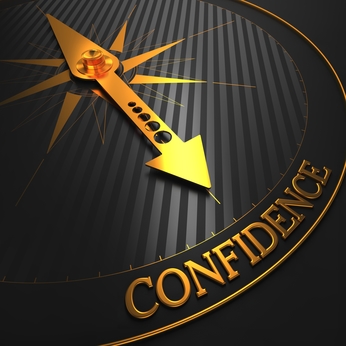 The leader purposefully strides to the front of the conference room table and is prepared to begin. Smiling warmly, she turns to the group, and asks the group a question. Since she wants their response she allows the pause to encourage people to participate. After creating a conversation, she clearly tailors her message to the group based on the initial conversation.
The leader purposefully strides to the front of the conference room table and is prepared to begin. Smiling warmly, she turns to the group, and asks the group a question. Since she wants their response she allows the pause to encourage people to participate. After creating a conversation, she clearly tailors her message to the group based on the initial conversation.
Without knowing anything more, would you expect people to trust her and her message more or less after the meeting?
If you are like me, your answer would be “more.”
In this short story, I have described a number of confident behaviors and without putting any message in the mouth of the leader, I’ve shown that the confident communication, in and of itself, created greater trust.
The situations and scenarios can vary but the fact remains: When we are seen as more confident by others, we will be more trusted.
When we communicate with greater confidence, we can engender greater trust.
So if you would like to be trusted more by others, one of the ways you can influence that positively is by communicating with greater confidence. And this is pretty cool – because it is a way for us to proactively influence the trust that we earn from others.
I’m guessing you are all agreeing with me at this point (an assumption that makes me more confident as it turns out), so let’s take it another step with the big question . . .
How can we do this (better)?
After all, if trust is good and there are things we can do in our communication to grow it; we would want to know those things, right?
Here are five ways you can.
Be better prepared. When you go into a communication situation with someone, are you ready? I know some communication is spontaneous, but much isn’t – and that is the focus of my question. Think beyond presentations (though you definitely need to be prepared then) to meetings, coaching sessions and phone calls. Before situations like these on your calendar occur, use your journal to identify what you want to accomplish and learn in that interaction. Think too about your audience, and think about what they may want from you in this situation. When you have planned for the meeting, you will begin more confidently, with less fumbling and stumbling – and that will lead to better results and will help the relationships too.
Pause (and breathe)! When someone never slows down and never takes a break when they speak, don’t they seem, at least a little bit, nervous? Perhaps it is just your natural rate of speech, but the perception is you are just trying to get through the communication as fast as possible (to get it over with). Slow down a bit. Take a breath. Pause. Doing these things create greater presence and seem to give a bit more weight to what we are saying. I am not suggesting theatrics or overdoing it – but I am suggesting that working on your pace might have a much bigger impact on your communication results (and trust building) than you realize.
Engage others physically. We engage people physically through our gestures, movements, facial expressions and eye contact. When we make eye contact our communication will be more effective. And who do you trust more, the person who looks you in the eye, or the one who avoids your gaze? Do I need to say more about this?
Engage others mentally. In the fictional example I opened with the leader engaged the group by asking questions. When we find out what others think we not only are building trust (“they really want to know what I think!”) by our actions, but building trust in the results of the conversation (people don’t argue with their own data). When we ask people’s opinions, acknowledge them and especially when we agree with them, trust grows quickly. Even if trust at the start of a conversation is at very low levels, as we consistently and authentically engage people mentally, we build trust.
Engage others emotionally. When we engage people mentally, we may also be building emotional connection as well. But it goes deeper than that. When we communicate with people at an emotional level, expanding the range of topics we touch or connecting business messages to personal examples, we are building an emotional connection and trust. People want to believe in something, and if they feel they can believe in you and your message, they will be pleased.
The Big Picture
Now that you have read these five ideas, do you see the connection?
They all take the other person in the communication into account – their time, their opinion, their time.
Here is (just one) example.
When we take the time to be prepared, we are truly more confident because of the preparation, but it will be seen by the other person that you took the time to be ready for them.
Doing the things suggested in this article will build trust in the messages you are delivering, and will build trust in you personally too.
A pretty good investment of your time, focus and energy, don’t you think?

Good point. Communication based on understanding is a very crucial point in any setting. And the planning part, why is it that so many skimp on this part of the process? Poor planning poor results. In a world of instant gratification, it’s time to slow down in order to get better results.